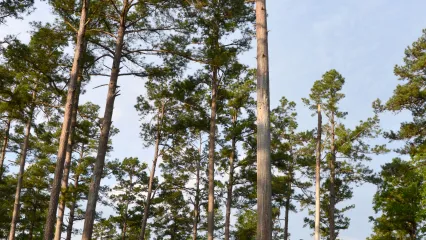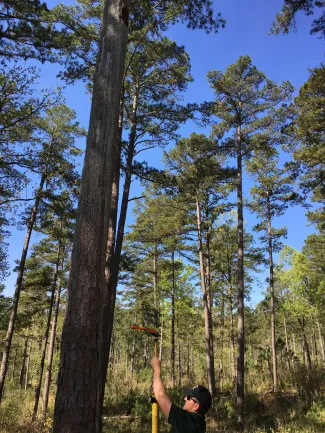For Clay Barnes and Jordan Shope, biologist and technician for the Oklahoma Department of Wildlife Conservation, going to the office means driving an ATV packed with climbing gear and a telescopic camera onto a small pontoon boat, crossing Broken Bow Lake, and then navigating the twisting trails within McCurtain County Wilderness Area’s 14,000 acres. Together, they manage the Wildlife Department’s original conservation area and the small population of red-cockaded woodpeckers that call the Wilderness Area home.
Each spring, the duo’s mission is to monitor the endangered woodpecker’s nest cavities.

“We had 11 breeding pairs of birds on the area last year, and expect a similar number this year,” Barnes said. “Like other woodpeckers, red-cockaded woodpeckers live and raise their young in holes they’ve drilled in trees. But this particular species only builds cavities in living pines infected with the naturally occurring red heart fungus.”
The fungus softens the wood, making it easier for the woodpeckers to hollow out a small cavity. But even with the softened wood, construction may take two years. To help the woodpeckers get a head start, Barnes and Shope install manmade cavities in trees.
“Red-cockaded woodpeckers are social and live in small family units in a group or cluster of trees,” Barnes said. “The birds have accepted these recruitment cavities and often roost and raise young in the boxes, sometimes drilling natural cavities in nearby trees.” The birds add a final touch to both manmade and natural cavities by chipping small holes in the bark around the entrances, producing sticky resin flows. Sap soon covers active roost trees, seemingly protecting the roosts and chicks from potential predators like snakes.
“The woodpeckers typically begin laying eggs in late April,” Barnes said. To find out if eggs have been laid in a cavity Barnes uses a bright yellow telescoping pole with a small camera attached at the top. “Most of our cavities are built about 30 feet above the ground,” he said. “Thanks to this ‘peeper cam,’ we can check a cluster of 5-7 trees within 15 minutes. Without it, we would have to climb each individual tree and use a small mirror to see into the cavity.”

Barnes uses a telescoping camera to check the status of each cavity.
When the camera reaches the entrance hole Barnes checks the handheld display and sees an empty cavity. “Nothing yet, but I don’t think it will be long before we find the first egg.”
The endangered woodpeckers only lay one egg per day until their clutch – averaging four eggs – is complete. “The eggs are solid white and rest directly on the cavity’s floor. There isn’t a stick or feather nest inside the cavity, but sometimes the eggs may be cushioned by wood chips,” Barnes said.
Once all eggs are laid, incubation begins and continues for 11 days.
“It may be surprising, but the eggs will actually be in the breeding male’s roost cavity,” Barnes said. “His is typically the newest cavity, so the resin flows are heavier and the eggs are better protected from predators.”
Barnes records the empty cavity in his field notebook and straps the camera’s telescoping pole to the ATV. As he starts the engine, he makes plans to return. “We’ll be checking the cavities at least once every two days. It’s possible we’ll have that first egg the next time we check this cluster of trees.”